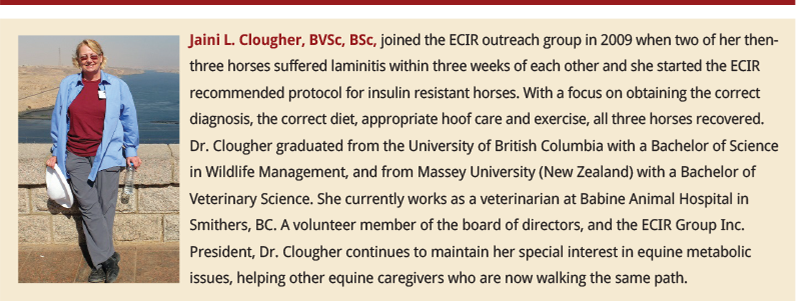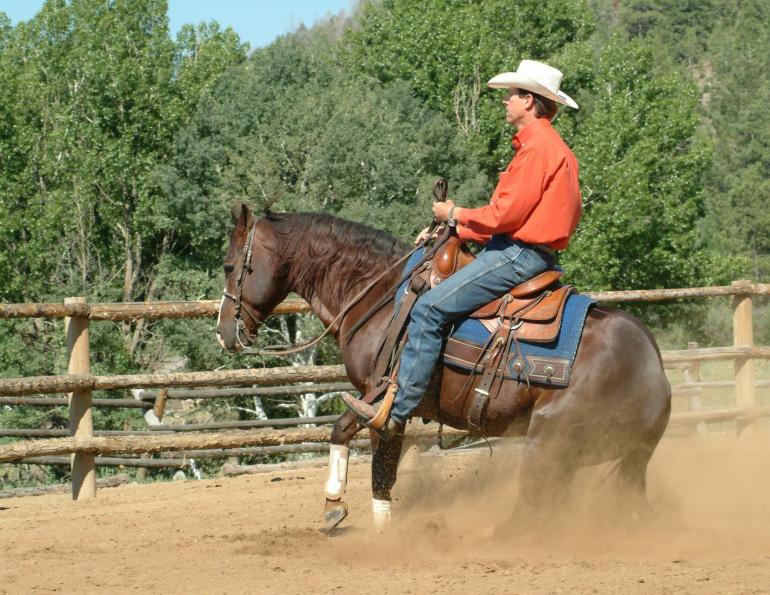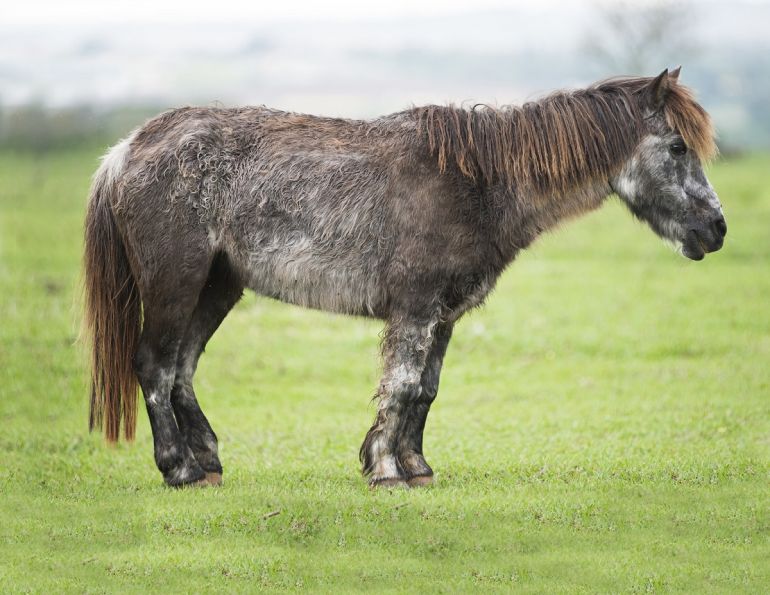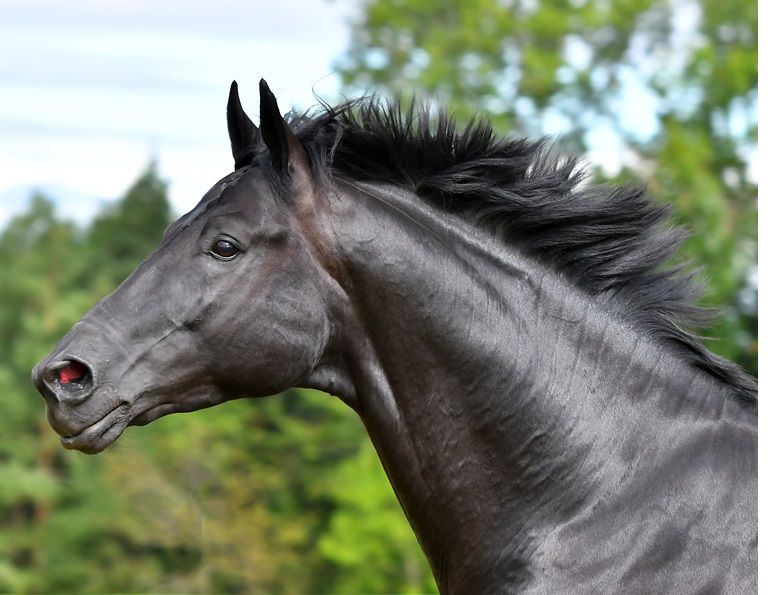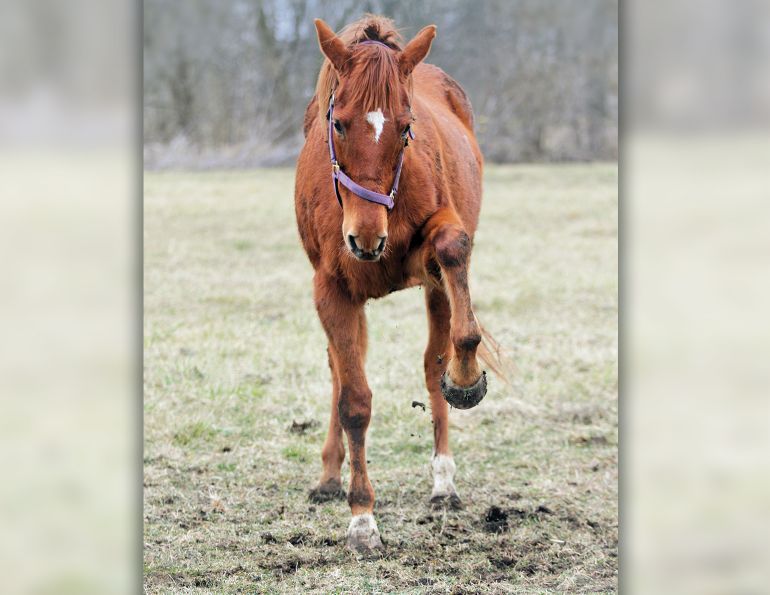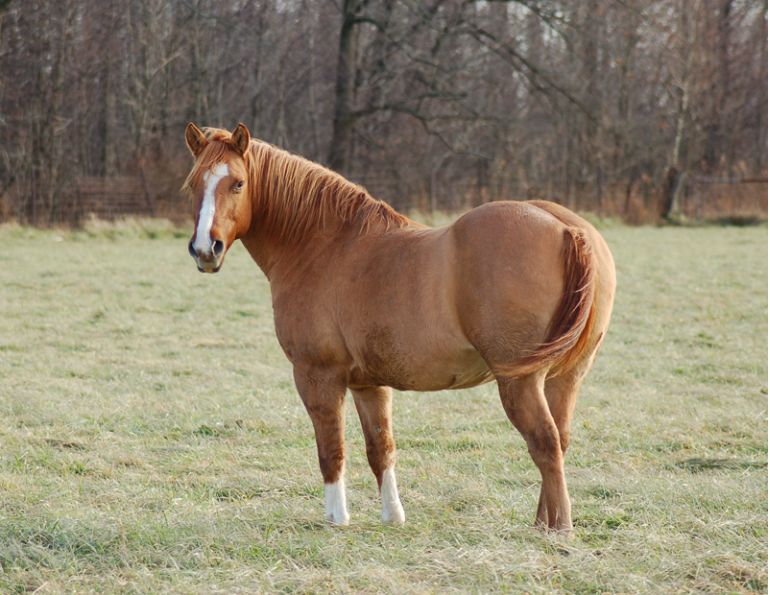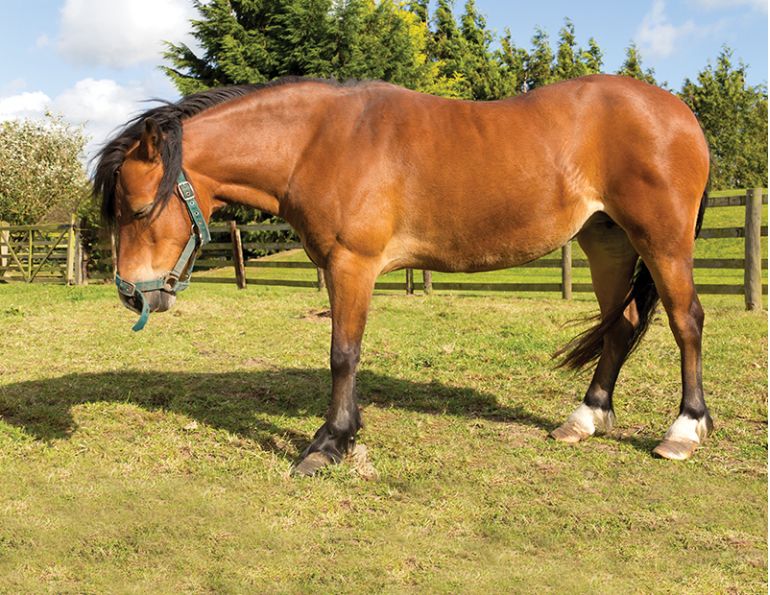By Dr. Jaini Clougher, President, ECIR Group Inc.
Equine Metabolic Syndrome (EMS) and Equine Cushing’s Disease (also known as Pars Pituitary Intermedia Dysfunction, or PPID) are reasonably common conditions we encounter in our horses. This article will deal primarily with EMS, but because PPID can be a cause of increased insulin levels in horses, it needs to be mentioned as well.
The terms used to describe these metabolic disorders can add to an already complicated picture. Some of these terms are:
- Hyperinsulinemia: Elevated circulating insulin, which can be transient after eating, or chronic. Chronic hyperinsulinemia can cause insulin resistance.
- Equine Insulin Resistance (IR): Tissues and organs resist insulin signalling.
- Equine Metabolic Syndrome (EMS): The terms EMS and IR tend to be used interchangeably. The term EMS is more correct, as it comprises the constellation of signs that include hyperinsulinemia, abnormal fat deposits, altered fat metabolism, hypertension, and risk for laminitis.
- Pars Pituitary Intermedia Dysfunction (PPID): Commonly known as Cushing’s Disease. It is distinct from EMS although horses with PPID can also have hyperinsulinemia.
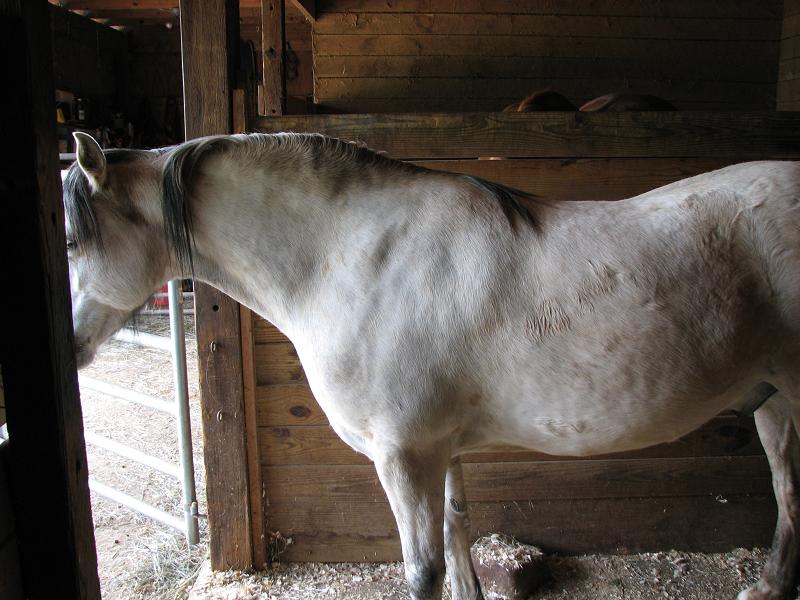
Abnormal fat in the crest, fat pads in front of shoulders and behind shoulders. Photo: ECIR Group Inc.
It is estimated that about 20 percent of horses over the age of 15 will develop PPID, while it is thought that about 10 to 20 percent of horses are insulin resistant to some degree. EMS and PPID can share some common clinical signs, the most devastating of which is laminitis.
Hyperinsulinemia is always a feature of EMS, but can also be present with PPID. Hyperinsulinemia is managed with diet and exercise; PPID is managed with medication (Pergolide), diet, and exercise.
The EMS metabolic type is largely a result of genetics that have enabled horses to survive, and even thrive, under adverse conditions. It makes sense to have an efficient metabolism if you are a wild horse in the Nevada desert, or a Shetland pony grazing scrubby heather in severe weather. This doesn’t work quite so well when the caloric needs of an energy-efficient horse are easily met (or over-met), and exercise is less than optimal. Breeds prone to develop EMS are ponies, minis, donkeys, Arabians, Morgans, Saddlebreds, Tennessee Walkers, Rocky Mountain Horses, Spanish horses (including mustangs), and a sub-set of Quarter Horses. Breeds that do not typically develop EMS are Drafts, Thoroughbreds, Standardbreds, and most Quarter Horses. It is important to note that not all individuals of EMS-prone breeds will end up with EMS; but if you own one of these breeds, managing them prudently and keeping your eyes open for warning signs is always a good idea.
Horses with EMS have abnormally increased levels of circulating insulin. Insulin has many functions, but one of the most significant is to promote glucose uptake by the cells. Every cell in the body needs glucose to function. With an EMS individual, the loss of cell sensitivity to the action of insulin causes the body to produce more and more insulin in order to get the job done. Horses as a species seem to be able to produce a nearly endless supply of insulin; thus, elevated blood glucose (diabetes mellitus) tends not to be a feature of EMS (although can occur in some horses).
A high level of insulin also reduces the utilization of fuels in fat and muscle; more fat gets stored than used, weight gain occurs, and a vicious cycle starts. There is still no consensus as to exactly how this particular chicken-and-egg issue works out: are some horses fat because they are EMS, or is EMS triggered by excessive obesity? Not all fat horses are EMS by any means; and not all EMS horses are fat. The jury is still out on this question, but keeping any equine on the lean side is usually more appropriate than having them too fat.
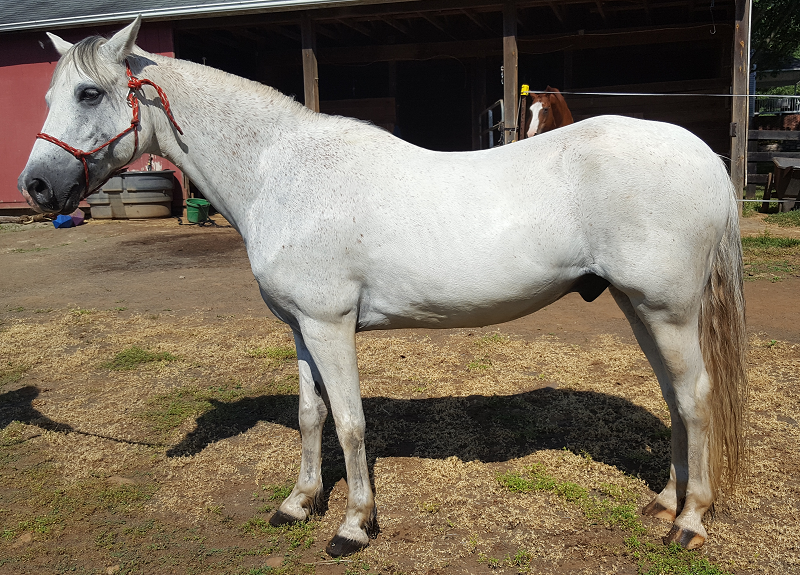
Abnormal fat over the tail-head. Photo: ECIR Group Inc.
Laminitis as a Consequence of EMS or PPID
High circulating levels of insulin have another, particularly devastating, effect: laminitis. Initially, following Dr. Chris Pollitt’s work in the early 2000s, in which laminitis was induced by an overload of chicory root inulin (a type of fructan), people concentrated on the fructan content of feeds as a cause of laminitis. It has since been shown that fructan-overload laminitis mimics the laminitis resulting from any septicaemia, such as occurs after a feed room break-in, severe colic, or placentitis. These horses not only have laminitis: they are systemically very ill, with high fevers, often explosive diarrhoea, and inappetence. However, these situations are not the most frequent cause of laminitis. It is estimated that over 80 percent of laminitis cases are caused by endocrine disorders with hyperinsulinemia as the main instigator. Other causes of laminitis include some infectious diseases (Potomac Horse Fever, Pigeon Fever, or Lyme disease, for example). Contact with black walnut shavings and sweet alyssum can also cause laminitis, although the mechanism is not at all well understood.
For a very good discussion of current theories about laminitis, see this article: Paradigm shifts in understanding equine laminitis, by Drs. Patterson-Kane, Karikoski, and McGowan.
Signs of Equine Metabolic Syndrome
Equine Metabolic Syndrome can be diagnosed by blood tests (described below). However, there are signs that an equine may have EMS and that testing is warranted. Clinical signs of EMS include odd fat deposits located in the hollows above the eyes, over or on either side of the tail head, behind the shoulders, and on the crest of the neck. These fat deposits are easy to spot if the horse is of a normal or below-normal weight, but in an obese horse they may blend in with the rest of the body covering. A gelding may have a swollen sheath and a mare may have a swollen udder.
A ravenous appetite often goes hand-in-hand with EMS, due to the horse being leptin-resistant as well as insulin-resistant. Leptin is the satiety hormone. If the horse’s body is not responding normally to the signal from leptin, the horse will have no appetite shut-off. This horse will be the one that never walks away from food and will eat everything given to it. Free-choice hay feeding of an EMS and/or leptin-resistant horse will result in obesity – and often in laminitis.
There may be increased drinking and urination (more common in horses that have progressed to the diabetic stage).
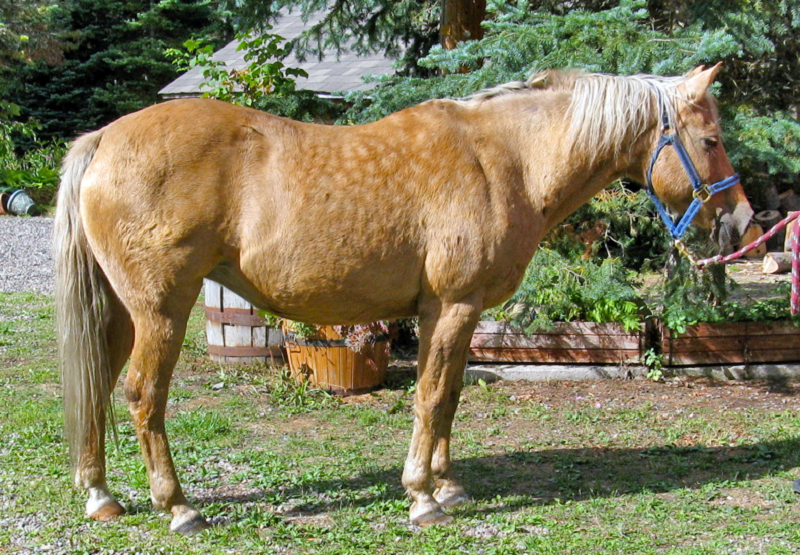
Maggie, EMS, with fat pads and a poor coat, before mineral balancing and a tight diet. Photo: Dr. Jaini Clougher
Low-level or sub-clinical laminitis is a common occurrence in EMS horses. The signs of this can be very subtle: the horse will be the last one running behind the herd and will be less likely to run and play. There may be some foot tenderness on hard ground. The horse may be reluctant to step out, and appear lazy or unmotivated at work (because his or her feet hurt). There may be chronic back pain that doesn’t hold chiropractic or other treatments. One useful indicator is how well the horse will execute a tight turn on firm or hard ground. If the feet are picked up and plunked down in much the same way as when the horse marches along at a normal walk, it is unlikely that there is foot pain. If, however, the horse appears to try to rock back to turn, and takes tiny, mincing steps, then something is not right. Horses with low-level laminitis often don’t show any obvious hoof pathology – there aren’t always telltale rings on the hooves. However, there will be continuing damage to the laminae inside the hoof.
Diagnosis of Equine Metabolic Syndrome
Correct diagnosis of EMS requires a blood test. A non-fasting blood sample is pulled in a quiet barn (don’t trailer to the vet clinic). Blood is spun and separated as soon as possible, chilled, and sent to the lab on ice. “Non-fasting” means the horse has hay available up to the blood pull, or is on pasture. Fasting blood samples are a hold-over from carnivores and humans; horses are “trickle-feeders,” and fasting samples can (and do) give falsely negative results. There may be a small increase in insulin for two to four hours after the very first hay/grass meal of the day if the horse has had no hay overnight, so schedule the blood pull four hours or more after the first meal of the day in that situation.
This is a good time to mention laboratory reference ranges. A horse can have an insulin that appears to fall within the laboratory reference range, and hence is “normal,” but these reference ranges cover a wide range of circumstances. While an insulin of 30 uIU/mL may be appropriate for a horse that has had a grain meal in the last couple of hours, it is a clear indicator of an abnormal insulin response in a horse that has been eating only low-starch and low-sugar hay. The best way to evaluate the insulin and glucose results is to plug them into the IR Calculator, which can be found on the ECIR website (www.ecirhorse.org) under the Insulin Resistance menu. This calculator was developed from the ground-breaking work at the Virginia Polytechnic Institute by Treiber, Kronfeld, Hess, et al, in the mid-2000s. Their exhaustive work on the Institute’s research herd allowed them to develop calculations that would predict which animals were at risk of laminitis, and hence were considered EMS.
The gold standard for diagnosing EMS in a research setting is to use an oral sugar test, as well as the intravenous glucose and/or insulin challenge. In practice, it is more desirable to use a single blood pull to check for insulin, glucose, and leptin, for two reasons. First and most important, if the horse already has high circulating levels of insulin, the addition of extra glucose to the system and the subsequent insulin spike can cause further damage to the hooves. The second reason is that the multiple blood samples (two or more) used in these tests adds expense. If a horse has all the appearances of EMS, but is still showing as non-IR in the IR calculator, then the oral sugar test may be appropriate. If the horse has an abnormally high basal insulin, then there is no need to proceed to the oral sugar test or an intravenous challenge test.
Dr. Eleanor Kellon, VMD, veterinary advisor to the Equine Cushing’s and Insulin Resistance Group, has developed a logical, systematic approach to equines with suspected endocrine conditions and/or laminitis. This approach is known as the Diagnosis, Diet, Trim, and Exercise protocol (DDT/E). Diagnosis is key to correcting any abnormal state, because one cannot know how to address the underlying cause of a problem without a correct diagnosis. For example, diet alone cannot control the issues seen with Cushing’s Disease; medication is also needed. If an equine has only EMS, then diet is crucial, and using Pergolide in an attempt to help is fruitless.
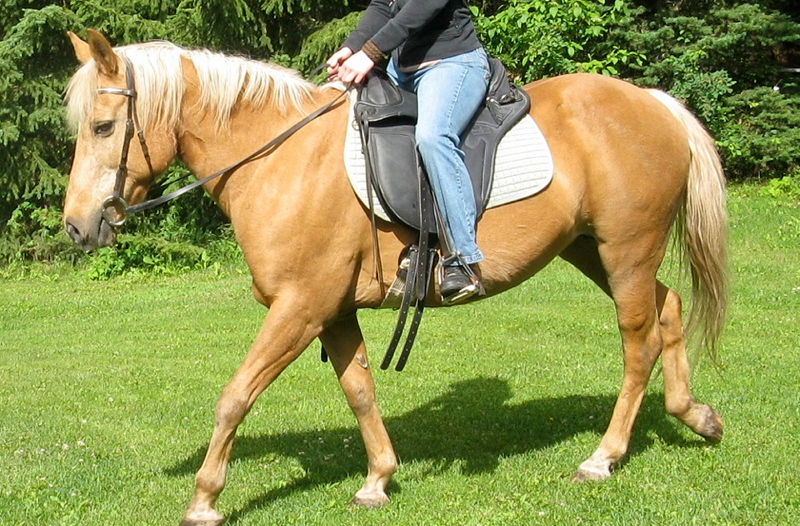
Maggie after mineral balancing. Photo: Dr. Jaini Clougher
Management of the EMS Equine
The basis of EMS management is to prevent insulin spikes or high circulating insulin levels by avoiding feeds that will cause these. The hoof is supported by a physiologically balanced trim, with or without shoes as the horse’s lifestyle dictates. A good exercise program further helps to keep insulin in check (but not if the horse is suffering from or has had a recent bout of acute laminitis, obviously).
Never force a laminitic horse to move. After an incidence of laminitis, one should wait a minimum of six to twelve months before riding. This corresponds to one-half to three-quarters of a cycle of good, tight, hoof regrowth. This also presupposes that the triggers which caused the laminitis have been removed, and that the trim is meticulous, allowing the hoof to grow out normally.
The appropriate EMS diet consists of forage (hay or haylage) with a soluble sugar (ESC) level plus starch level of less than 10 percent combined. The starch level should be less than four percent, and fat should be less than four percent (high-fat diets can exacerbate or even cause EMS). Pasture is not safe at any time for an EMS horse, so a dry lot system with the grass removed is ideal.
All dietary components need to be below 10 percent ESC plus starch. It doesn’t work to give some high-sugar feeds plus the hay in the hopes that the average over 24 hours will be below the ESC and starch limits: even a relatively small amount of inappropriate feed can cause an insulin spike and resulting damage to the laminae. This means no apples, carrots, starchy feeds, or most bagged feeds. Safe bagged feeds include rinsed/soaked/rinsed beet pulp; soy hull pellets; Ontario Dehy Timothy Balance (ODTB) cubes; and Hi-Pro Pro Fibre Crunch. For those of us who clicker train, the ODTB cubes work very well, with beet pulp pellets as low-value treats, and Pro Fibre Crunch as high-value treats. Since most EMS horses do not need to put on weight, the only reason to use these bagged feeds is to serve as a method to get the horse to ingest added vitamins, minerals, and supplements needed; as treats; or for clicker-training.
Ideally, hay should be analyzed, and then one can get a mineral mix that is customized to the hay. There are a couple of laboratories in Canada that can provide this forage testing: A&L Laboratories in London, Ontario; and Nutrilytical/Agritrend in Calgary, Alberta. Mad Barn makes custom mineral mixes.
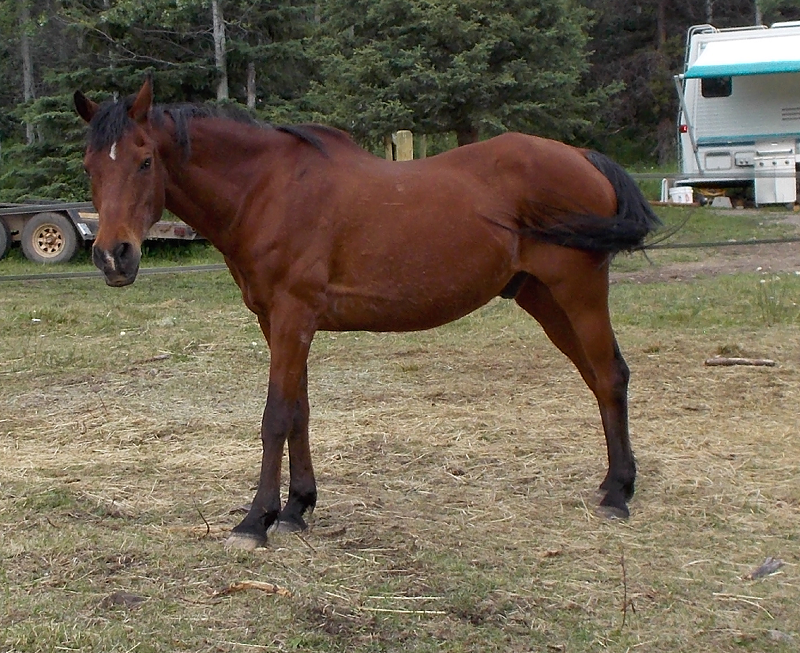
Merlin, EMS and PPID, age 35. Photo: Dr Jaini Clougher
If it is not possible to analyze hay, then there are three acceptable ration balancers in Canada: Omneity Vitamin and Mineral Premix or Pellet from Mad Barn; Amino Plus Pellet from Mad Barn; or Le Cheval au Naturel mix from VifArgent. In addition to the balanced mineral mix, one should add 2,000 IU of vitamin E per average-sized horse, plus one-half to three-quarters cups of ground, stabilized (or freshly ground) flax to replace the omega-3 fatty acids that are lost in hay curing.
I myself have three EMS horses (we used to have four). Two of the three are also PPID (as was the fourth, now departed and greatly missed). Although it initially seems weird and onerous, managing an EMS equine soon becomes completely routine.
For more information, plus tips and ideas for managing an EMS or PPID equine, visit the ECIR Group website and join the Outreach Group.
Main article photo: Dreamstime/Nigel Baker
This article was originally published in the Early Summer 2018 issue of Canadian Horse Journal.
